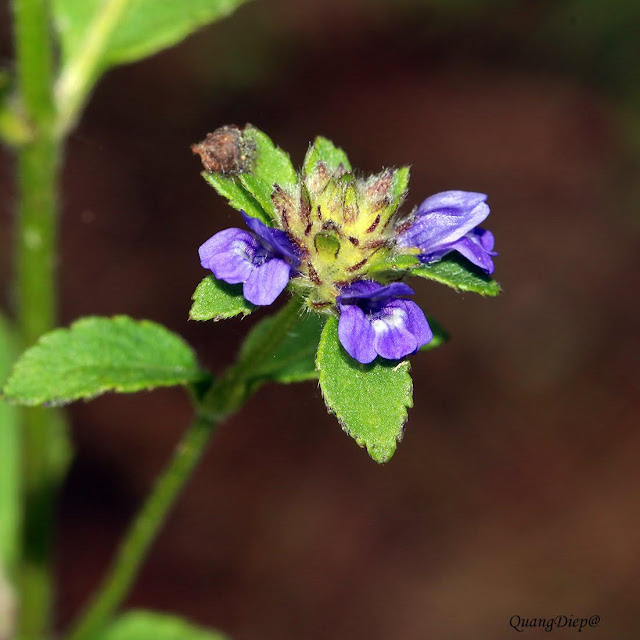Adenosma indianum (Lour.) Merr.
 |
| Adenosma indianum (Lour.) Merr.; Photo by Dinh Quang Diep |
Botanical
name: Adenosma indianum (Lour.) Merr.; Family Scrophulariaceae
Synonyms: Adenosma capitatum (Benth.) Benth. ex
Hance; Manulea indiana Lour.; Pterostigma capitatum Benth.; Pterostigma spicatum Benth.; Stoechadomentha capitata Kuntze
Local names: Bồ bồ, Chè đồng, chè nội, chè cát, nhân
trần hoa đầu
Description: Annuals, 19-60(-100 or more) cm
tall, densely hairy. Stems erect, branched. Petiole 2-6 mm; leaf blade ovate to
narrowly elliptic, 1.5-4.5 x 0.5-1.2 cm, densely glandular hairy, abaxially
villous along veins and brown when dry, adaxially villous and blackish when
dry, margin serrate, apex obtuse. Inflorescences globose to cylindric spicate,
0.7-2 X 0.7-1.1 cm, dense; bracts narrowly ovate, forming an involucre at base
of spikes. Flowers sessile. Bracteoles linear, 3-4 mm. Calyx 4-5 mm; lobes
narrowly ovate to oblong-lanceolate, 2-3 mm, apex acuminate. Corolla pale
purple to dark blue, ca. 6 mm; throat hairy; lower lip lobes equal,
suborbicular, ca. 1 X 1-1.2 mm; upper lip retuse to 2-lobed. Anterior anthers
with 1 locule fertile; posterior anthers with both locules fertile. Ovary
narrowly ovoid. Capsule ovoid, ca. 3 mm, 2-grooved. Seeds yellow. Fl. and fr.
Sep-Nov..
Adenosma indianum (Lour.) Merr.; Family Scrophulariaceae
Distribution: Commonly found wild in mountainous regions,
especially on hillsides and field-edges.
Parts used:
The whole plant is collected in summer
during its flowering period (Herba Adenosmatis Indiani). It is carefully washed then
subjected to thorough air-drying.
Chemical
composition: The
plants contain triterpenoid saponins, phenolic acids, coumarins and flavonoids.
The volatile oil from the plant consists of L. fenchone 35%, limonene 22.6%,
cineol 5.9%, piperitenon oxide and sesquiterpene oxide.
Therapeutic
uses:
The whole plant,
except the roots, constitutes an antibacterial, cholagogic, diuretic and
stomachic remedy. It is useful for the treatment of jaundice in viral
hepatitis, oliguria, biliuria, fever, ophthalmalgia, vertigo and dyspepsia in
parturients. It is prescribed in a daily dose of 10 to 20g in the form of a
decoction, extract or syrup.





0 Comment:
Post a Comment